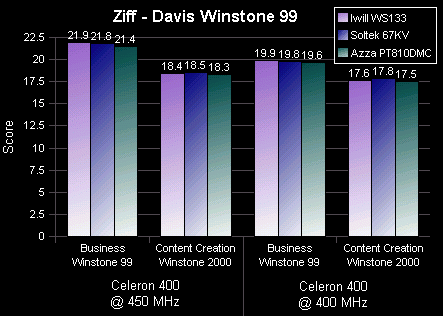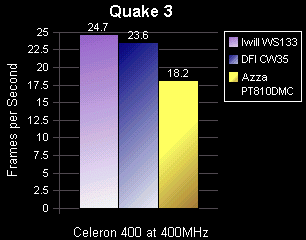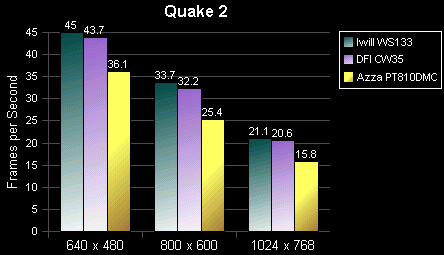
|
For the entry-level / budget conscious user, manufacturers have provided a solution to this market in the form of integrated motherboards. With onboard graphics, audio (usually in the form of an AC97 audio CODEC) and at times including RAID, SCSI, or an Ethernet solution, all-in-one motherboards have been accepted and implemented on a relatively wide scale.
70% Rating: 
|
|
|
|
Home >
Reviews >
Motherboards >
Iwill WS133 |
|
|
Winstone Performance and Gaming Performance
For this benchmark,
Winstone 99 and Content Creation Winstone 2000 have been used to test the
overall performance of the test bed setup. Winstone 99 (Business Winstone 99)
v1.2 is used to test the overall business performance of the computer system by
using applications such as MS Office 97, Lotus Smartsuite 97, etc. Content
Creation Winstone 2000 is a system-level, application-based benchmark that
measures a PC's overall performance when running today's Windows-based Internet
content creation applications. The test focuses on top-selling Internet content
creation applications.
Each test was run 3 times with the result being
the average value of the 3 test runs. Higher numbers indicate better
performance.
In order to put the Iwill WS133 to the test, the following
configuration was used. For comparative purposes, we have included the results
of other boards tested previously on PCStats with the same configuration. Here
is the test platform...
Test Bed Setup
- Celeron 400 PPGA
CPU
- Soltek SL-02A++ "Slocket" Adapter
- 128MB PC100 SDRAM (CAS-2)
-
8.4GB Quantum Fireball CR Hard disk
- Windows 98 (First
Edition)
Other boards in this comparison
- Soltek SL-67KV
(VIA Apollo Pro 133A)
- Azza PT-810DMC (Intel 810)
- DFI CW35 (Intel
810 -- for graphical reference only!)
- The latest drivers for each
motherboard was used

Gaming
Performance
Here we will add performance scores of the DFI CW35 in addition
to the Azza PT-810DMC. As the test bed used for the DFI CW35 consists of
different hardware, it would be incorrect to add Winstone scores of the CW35 and
these numbers are influenced by the system in its entirety. However,
once a game is loaded into memory (hence cached), the scores become less
dependant upon various components and rely more on the graphics subsystem of the
motherboard. RAM would certainly play a part in this comparison but only to a
limited extent. You can consider the gaming performance scores as an indication
of how the WS133 performs against its competitors.
Being a low-priced
solution for OEMs and system integrators, the 810 chipset line does not offer
cutting edge performance as today's add on cards do. Basic and occasional gamers
will find the WS133 sufficient enough for their needs. Hardcore gamers need to
look elsewhere for higher frame-rates.


As you can see from the
graphs above, the Iwill WS133 takes the lead in performance (albeit by a slight
margin) in each category. Practically, you may not notice much difference in
performance on a day-to-day basis but you certainly will not find it any
slower.
The Azza PT810DMC is not equipped with an in built 4MB display
cache, hence the use of system memory. The WS133's display cache runs at a
decent 133MHz which certainly will increase 3D performance by around 20%-25% as
you can see above.
|
